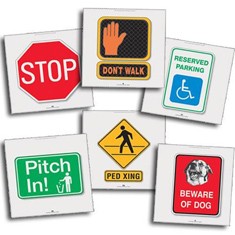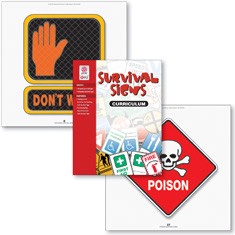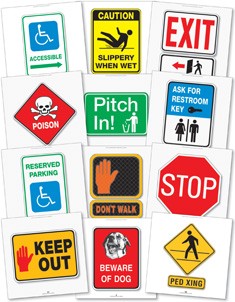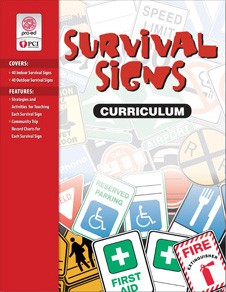- Reading Level Nonreaders
- Grades / Interest Level 2 - 12
- Format 12" x 12" posters (40)
-
Product Code 20600 ( MR #054302 )
Price $53.00
These 20 posters cover 40 survival signs found on neighborhood and city streets, in parking lots, by bus stops, on fences, at construction sites, near pools or lakes, near schools or work sites, and more. Includes Airport, Bus Stop, Do Not Enter, Fire Station, High Voltage, No Parking, One Way, Ped Xing, Railroad Crossing, Stop, Wrong Way, Yield, and more.
PCI's Janie Haugen-McLane developed the Survival Signs Curriculum to give teachers a step-by-step way to help students learn the meaning of 80 indoor and outdoor signs found in the community, at home, and in the workplace.
The curriculum instruction method gives detailed explanations of both the visuals and the words on each sign. A perfect teaching tool for the inclusive classroom, the guide includes discussion activities and charts for the teacher to record the various places in the community where each sign is located. Students who are nonreaders or who have limited reading skills can rely on visuals on the survival signs to determine each sign's meaning. The overall purpose of the program is to prepare students of all abilities to follow the directions on common community survival signs to travel safely in their community.
Outdoor Survival Signs
- Airport
- Beware of Dog
- Bike Route
- Buckle Up for Safety
- Bus Stop
- Call 911 Emergency
- Do Not Enter
- Don't Walk
- Fire Station
- Flood Gauge
- High Voltage/Danger
- Hospital
- Keep Off the Grass
- Neighborhood Crime Watch
- No Bicycles
- No Diving
- No Parking
- No Swimming
- No Trespassing
- No Walking
- One Way
- Pedestrian Crossing
- Phone
- Picnic Area
- Pitch In!
- Railroad Crossing
- Reserved Parking/Disabilities
- School Xing
- School Xing/Hearing Impair
- School Zone/Speed Limit 20
- Signal Ahead
- Slow/Children at Play
- Speed Limit 30
- Stop
- Stop Ahead
- Street Crossing
- Walk
- Wrong Way
- Yield
- Yield Ahead
No additional information available for this item.

 Proud to be Canadian
Proud to be Canadian



